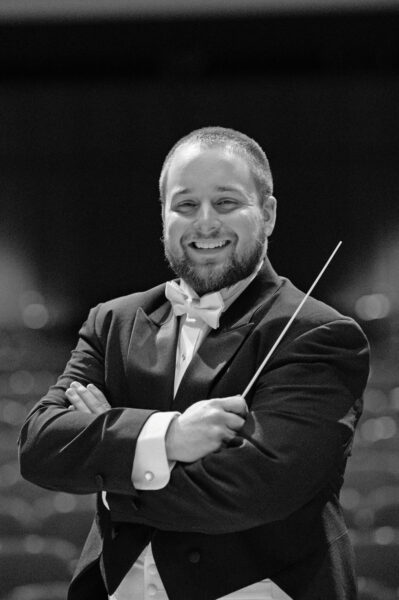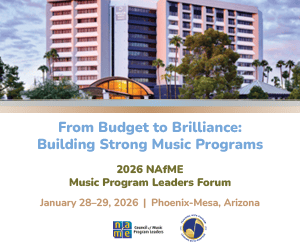/ News Posts / The Changeover Box: Ensuring Continuity during a Director Change
The Changeover Box
Ensuring Continuity during a Director Change
By NAfME Member Christopher Brandt
This article first appeared in the October 2022 issue of Teaching Music. All archives are available to NAfME members.
Here are some tips and best practices to help ease a transition in a music program.
In a 4×100 meter relay, four runners each complete a 100-meter portion of a 400-meter race. Beyond the conventional challenges facing runners in solo races, relay races incorporate an added element wherein runners must relinquish baton to their teammate mid-race. This transfer must occur in what is known as the changeover box, a 20-meter segment situated on either side of the starting line. To avid racers or spectators, the changeover box is fraught with speculation and unease, as the slightest misstep between the two racers can quickly lead to violations, or worse, a drop. In an event where placements are often determined by tenths of seconds, the slightest hesitation can alter the trajectory of a race.
Similarly, the wellness of a music program is never more precariously perched than during a director change. The transition from one director to another is an opportunity for years of institutional and procedural knowledge to vanish from a program. While some programs are fortunate enough to have multiple directors, which can certainly insulate from this loss, many more programs throughout the United States have only a single director, making this handoff all the more perilous.
A comprehensive changeover from one director to another generally contains two components, with the possibility of a third. The first component is a document handoff, often in the form of a flash drive or cloud transfer containing files, spreadsheets, and documents pertaining to budgets, inventories, and music libraries. The second component is a letter or document wherein the outgoing director provides an overview of the program and key details about the day-to-day responsibilities of the position (key contacts, processes, resources). The handoff document is meant to take to the place of the third component, which is not always possible: a position overlap or a handoff meeting between the incoming and outgoing directors.
Position Handoff Letter
While the exact content of a position handoff letter can vary from program to program, the following list offers a useful starting point. Some of the contents could be moved from the letter to the document handoff or vice versa depending on the situation.
- Introduction and Contact Information
- Program Overview
- Key Contacts
- Overview of Physical Spaces
- Essential Processes
- Technology Overview
- Projects or Events in the Works
- Items Included in Document Handoff
While this list may seem daunting, keep two key thoughts in mind: First, you will be writing this for another busy music educator who will have as little interest in reading a lengthy, verbose essay as you would have in writing it. Brevity and clarity are paramount. Second, the purpose of these strategies is to facilitate a smooth transition, minimizing lost momentum, and ensuring that student learning and experiences are not adversely affected.
Introduction and Contact Information
Imagine this as a handshake from you to the incoming director. Introduce yourself, mention how long you have held the position, and if you are comfortable, communicate where you are moving on to and give your email address and phone number. Indicate just how open you intend to leave the door for the incoming director to reach out. Are you retiring and moving out of state, or are you staying local? Are you moving within the district or changing careers entirely? The specifics of your next endeavors are not the primary message, but rather how available you intend to be should the new director have questions. For example, which groups are auditioned, and which are open to all? Is the marching band comprised of volunteers, and do they play for all home football games, participate in the homecoming parade, and compete in one competition annually? This information provides context but does not obligate the new director to follow the traditions of past years.
Program Overview
Skip any information that was likely in the job posting. The incoming director should already be aware that there are, for example, two concert bands and two jazz ensembles, and if not, that is something they will quickly learn from their new principal. This overview should convey essential information about the program that the incoming director might have a hard time finding on their own.
Key Contacts
Include any contacts needed frequently or required for essential tasks. This includes contacts for purchase orders, room reservations (concerts, football field), maintenance, music boosters, school technology, local music store(s), and anyone with institutional knowledge who seems to know the answer to every question about the school (usually one of the administrative assistants). Other contacts include any prominent supporters of the program and any parents or community members who consistently step up to help when needed. Also identify any student leaders in the program. While it might be tempting to “warn” a new director about certain individuals or students, doing so will likely do more harm than good.
Overview of Physical Spaces
What spaces are generally used for rehearsals? Which field can the marching band use? Does the program store uniforms in the storage closet near the theater? Assume that the new director will find their way to the main rehearsal hall but may not know that the classroom across the hall is empty on Tuesdays and Thursdays and can be used for sectionals. Make the new hire aware, for example, that extra music stands are stored in the orchestra pit.
Essential Processes
Every district has slightly different procedures for tasks such as purchasing, transportation requests, equipment check-out, and more. One cannot create a manual to cover all aspects of one’s job; however, a brief overview of the key components of a position can be extremely helpful. Remember that brevity is key: Short, concise bullet points can often be just as effective as paragraphs. Items to consider including are:
Purchasing procedures. Whom to contact? How far in advance? Are there different procedures for repairs versus consumable goods (reeds, valve oil) versus sheet music versus capital expenses (instruments or uniforms)?
Scheduling procedures. Is scheduling done with the principal or the activities director? Is it done each semester, or are all dates set a year in advance? Have the dates for next year been set? How are rehearsal and performance spaces reserved (auditorium or gym or football field)?
Instrument and equipment checkout. Is there a usage fee for school-owned instruments/equipment? Is there a usage contract? When and how are uniforms cleaned?
While some of these processes are likely determined at a district- or building-level and therefore unlikely to change, others have may been established by you or your predecessor and therefore can change. The purpose of sharing these processes is to provide context for the incoming director and to make them aware of what expectations current students, families, and administrators may have. However, once the changeover is complete, these decisions fall under the purview of the new director and may, therefore, be altered.
“The wellness of a music program is never more precariously perched than during a director change. The transition from one director to another is an opportunity for years of institutional and procedural knowledge to vanish from a program.”
Technology Overview
What technology resources are available in the program, and what is the relevant log-in information? Does the program have a SmartMusic account or a stand-alone website or social media presence? Is the inventory or music library uploaded to a resource management platform such as Charms or Cut Time? Having the account information for all these resources compiled in one place will be extremely helpful to the incoming director and will, in all likelihood, prevent a frantic call to you later. Last, although these items are likely listed in the equipment inventory included in the document handoff, if there are any large (or expensive) technology items such as a Harmony Director, a set of iPads, or specialized recording equipment, it is helpful to mention these.
Projects or Events in the Works
Are you leaving any irons in the fire that the incoming director should be aware of? Is the program scheduled to take a trip next spring? Are there any major fundraisers already scheduled? Other questions to consider are whether a marching band or show choir performance has been announced for the following year. Have any additional staff already been contracted for the summer? Has drill/choreography or music been ordered? This final section can also act as a catch-all for any other important information that may be beneficial for the new director to know. Are there any important traditions within the band program? Any unwritten rituals that the new director should be
aware of?
Document Handoff
During your time at a given position, you have likely acquired or created several resources that help the program run smoothly and efficiently. Some of these files fulfill essential functions such as budgeting and equipment management, while others may simply be helpful documents such as a beginning band sing-up form or a parent letter. Knowing the many responsibilities entailed in our profession, it can be a great service to your successor to pass these resources on, so the new director won’t have to reinvent the wheel.
Such a handoff can be particularly helpful for first-year directors, who likely need to create every document, letter, and spreadsheet from scratch. Conferring these resources on your successor will not only save them precious hours but will also help ensure continuity through the transition. (While the new director may choose to use only some of the provided resources, they will help further inform them of the norms in the program and community they are joining).
A best practice for the transmission of these documents is via an external memory device such as a flash drive. While these forms and documents likely exist on a school device and possibly on a network drive, the transition of account profiles and log-ins is not always seamless, and a well-meaning IT specialist could easily discard old files in an effort to prepare a device or account for the incoming director. For these reasons, it helps to consolidate all handoff documents onto a single flash drive to leave along with the handoff letter.
Alternatively, you could provide the new director with a link to a shared drive where the documents exist. The new director should download these files to a local device or transfer them to their own drive to avoid inadvertently deleting essential original files from a shared drive.
Other items to include are:
- Budgeting documents
- Instrument/equipment/library inventory
- Comprehensive calendar from previous year
- Recent concert programs and/or repertoire list
- Recent performance recordings
- Any other created forms that might be helpful
With budgeting documents, identify account numbers and general budgeting amounts so that the incoming director can begin their planning and also avoid any accidental modification in allocations. For example, the budget from the office might show a much higher total amount for the music program than the new director had expected, and not having a context for what is “normal,” they might overspend. Conversely, a budget-conscious administrator may use the transition as an opportunity to trim some of the program budget, assuming the new director (without context) will accept it as the norm.
“The purpose of sharing these processes is to provide context for the incoming director and to make them aware of what expectations current students, families, and administrators may have.”
A library inventory and comprehensive calendar can be extremely helpful in facilitating the transition to a new director as they tackle two of the most pressing items facing any new director: scheduling and programing. When I took my first position leading a high school band straight out of college, there were countless events and performances that seemed to appear out of nowhere throughout the year. Instances of “the band has always performed at the fall festival” or this pep rally, or the Kiwanis breakfast, etc. came up quickly, often with only a few days’ notice. The previous director had been in the position for so long that there was an abundance of unwritten expectations that created unnecessary stress and last-minute scrambling.
A comprehensive calendar spanning the entire year will give the new director a full picture of the events and expectations for the program. Providing recent programs, repertoire lists, or recent recordings can help the new director understand the general proficiency level of the various groups and guide their repertoire selections for the following year.
A Smooth Handover
The 20 meters that make up the changeover box of a relay race are by far the most treacherous meters of the 400-meter race. A slight misstep or miscalculation could torpedo a team’s chances to win the race. Similarly, the transition of a music program form one director to another can significantly impact the trajectory of the program. If done well, it can propel the program forward, capitalizing on the efforts of both the outgoing and incoming directors. If done carelessly, it can counteract years of positive momentum and stall progress.
The United States military and the business sector have learned to adapt during transitions to minimize momentum and knowledge loss through Change of Command Memoranda (a handoff letter) and by instituting position overlap where the outgoing person spends weeks or months assisting the incoming member so that individual can more easily get up to speed. While such an overlap may not be possible in education, its intent can be achieved by the implementation of many of the recommendations found here.
Remember that the nature of education is such that no two programs are alike, and, therefore, no listing could possibly account for every program’s situation. I hope that the ideas presented here offer an outline and jump-off point for a comprehensive handoff packet appropriate for each program’s needs.
Image at top: treety / iStock / Getty Images Plus
About the author:
 NAfME member Christopher Brandt is an assistant professor of music and the director of bands at Graceland University, Lamoni, Iowa.
NAfME member Christopher Brandt is an assistant professor of music and the director of bands at Graceland University, Lamoni, Iowa.
Interested in reprinting this article? Please review the reprint guidelines.
The National Association for Music Education (NAfME) provides a number of forums for the sharing of information and opinion, including blogs and postings on our website, articles and columns in our magazines and journals, and postings to our Amplify member portal. Unless specifically noted, the views expressed in these media do not necessarily represent the policy or views of the Association, its officers, or its employees.
Published Date
May 20, 2025
Category
- Ensembles
- Music Educator Workforce
- Program Development
- Retention
Copyright
May 20, 2025. © National Association for Music Education (NAfME.org)





